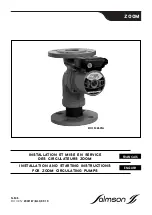
12
5.6. Ventilating exhaust air
You must vent the exhaust to a safe place, away from people, animals, food, and all sources of
ignition when pumping flammable or hazardous fluids. Note that when there is a tear on the
diaphragm, the media in the pump will be exhausted together with the air. To avoid this exhaust
the gas away from the operation environment. The pump exhaust air may contain contaminants.
Ventilate to a remote area if the contaminants could affect your process.
When transferring hazardous fluids, follow the steps below:
1-
Remove the muffler from the exhaust port.
2-
Install a conductive and grounded air exhaust hose with the minimum diameter of 1/2 inch 13
mm ID.
If a hose longer than 4.5 m is required, use a larger diameter hose. Avoid bending the hose
sharply.
3-
Place a suitable conductive container at the end of exhaust hose to catch the fluid in case
diaphragm ruptures.
Figure 9- Ventilating exhaust air
WARNING !
When you are transferring hazardous fluids or the pump temperature is over
60C, operator has to make precautions to drain the fluid.
WARNING !
FIRE AND EXPLOSION HAZARD
If you are working with flammable fluids, be sure to take precautions around
the pump while cooling it. You must vent the exhaust to a safe place
IMPORTANT NOTE :
If the diaphragm pump is submerged in water it is important that the fluid will
not enter the air exhaust system. To ensure this please use the special
exhaust cover with suitable attached hose with hose exit not submerged in
fluid.










































